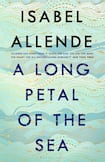
Beginning in the final year of the Spanish Civil War, when it is becoming clear to Victor Dalmau and Roser Bruguera that the Republican cause is doomed to fail, Isabel Allende’s A Long Petal of the Sea covers half a century of political and social upheavals across Spain and Chile. When the two protagonists become refugees, Roser flees across the Pyrenees whilst heavily pregnant, eventually giving birth to Victor’s brother’s son, whose father is killed in battle. Victor, who marries Roser platonically in order to gain passage to a ship outfitted by the Chilean poet Pablo Neruda, has worked as a medic in the battlefield, and the two escape to Chile to seek a better life.
Though this novel does not have the magical realism of some of Allende’s other work, it retains a romantic sweep. This generational saga, carrying the reader from the 1930s right through to the early 1990s, is stacked with historical detail, though it often feels like the research takes prominence, and characters take a back seat in their own story. Often, that means that stereotypes come into play, or the characters themselves become emblematic of certain archetypal figures. The two brothers with which the story begins, for example, are Guillem and Victor, one is bulky, manly, and a warrior, the other is skinny, romantic, and poetic.
The book is taut with desire, and the practicalities of marriage, births and familial relationships provide an effective network of restrictions against which Allende can explore the tug of lust and love. That said, Allende often succumbs to broad brushstrokes in defining her characters’ sexual relationships, which again become essentially emblematic of societal binaries. There is “natural chivalry”, much talk of chastity and Catholicism and the “free love” of revolutionary Spain, but also a quite heteronormative emphasis on reproduction as the means by which women become beautiful: “He remembered her as being skinny, with narrow hips and a flat chest, thick eyebrows and strong features: the kind of woman who has no false pride in her looks, and who, with age, would become lean or masculine. The last time he had seen her was in December, with a bulging belly and a face covered in acne. Becoming a mother had softened her, giving her curves where before she had only angles. She was breast-feeding her baby, and had large breasts, clean skin, and lustrous hair.”
Such descriptions are carefully done, but all serve the basic traditionalism of the plot, which is quite old-fashioned in its epic, romantic arc and can lapse into dullness.
Allende’s prose style in A Long Petal of the Sea can become tiring, which is disappointing considering the potential of the plot. There is a huge amount of surface detail, both historical and personal, and a reader can only admire the extent to which Allende must have researched some of the scenes here. However, we never fully see through the eyes of the characters, nor is the emotional resonance of the book really drawn out. Rather, Allende moves quickly, filling each page with detail. One thing happened, and then another happened, and this is what X thought of it, and then another thing happened. After a few hundred pages, the reader still doesn’t really know the inner lives of the characters, and the stacking up of detail can become tedious, leaving little compulsion to continue.
The real substance of the novel is in the history of modern Chile, its relationship with democracy, socialism, and migration. Despite the violence of its historical focus, Allende’s book is ultimately optimistic, and dovetails purposefully though implicitly with our current political climate. Victor himself, we learn, was a friend of Allende’s, and died six days before the final manuscript was finished. Allende’s godfather and first cousin, Salvador Allende, also features throughout the novel, being the first socialist president of Chile. This colours Allende’s vision slightly, but not enough to mar the historical vision of the novel.
In a short note to the reader, placed like a lens at the opening of the novel, Allende homes in on anti-immigrant rhetoric, despotism and the plight of refugees. She also gives this a personal tone, asking questions about how the history of migration has affected her own life and her own sense of self. “Where do I belong? Where are my roots? Is my heart divided or has it just grown bigger?” Through the ravages of political, social and personal upheaval, the characters in A Long Petal of the Sea ask similar questions, and the world opened to the reader is rich and varied, though its potential is greater than the emotional voltage it carries.











